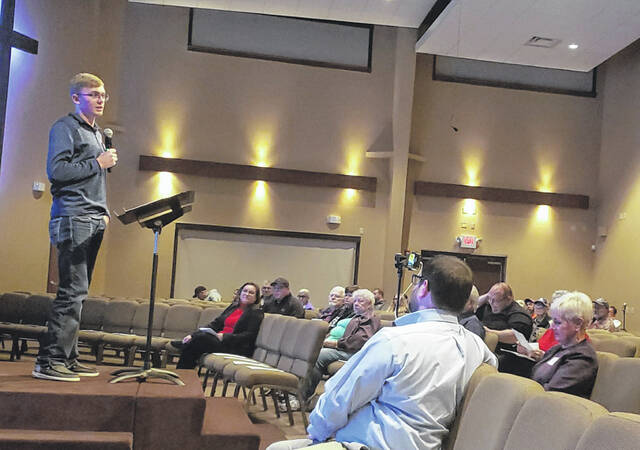
Landon Haney of Arcanum, fifth-generation farmer and president of his local FFA chapter, voices concerns over a large proposed solar project in Darke County
Tammy Watts | The Daily Advocate
By Tammy Watts
DailyAdvocate.com
GREENVILLE — A large group of concerned citizens filled the sanctuary of EUM Church in Greenville on Monday night to attend a panel discussion organized by the Darke County Citizen Preservation Association (DCCPA.) The purpose of the meeting was to raise awareness and voice grievances about the potential negative impacts that a proposed solar energy project by Apex Clean Energy, of Charlottesville, Va., will have on the land, health, and culture of Darke County.
The first speaker of the evening was Preble County Commissioner Rachel Vonderhaar, who was a proponent of Ohio Senate Bill 52, which gives counties control over large wind and solar projects.
“I’m not saying I’m for or against solar power, but I have an issue with taking fertile acres for an inefficient energy source,” she stated, pointing out that a mere 1/32 of earth’s surface is suitable for agriculture.
Next at the podium was Landon Haney, a fifth-generation farmer from Arcanum, and president of his chapter of Future Farmers of America (FFA.) He shared that while land leases to the solar project last from 30-50 years, “this is never going to be farmable ground again.” He also pointed out that two percent of the United States’ workforce is employed in a position directly related to agriculture. Seed sales, fertilizer manufacturing, and grain elevator operations are just a few of the industries that would be negatively affected by loss of agricultural land.
The proposed Painter Creek Solar Project consists of 2,400 acres (two to four square miles) throughout parts of Greenville, Van Buren, and Neave Townships. Five miles of new roads would wind through the solar field, with 300 posts per acre, raising questions as to how viable the land would be once decommissioned. Another concern is that connecting cables buried deeper than three feet would never be removed, which was confirmed by Drew Christensen, an Apex representative in attendance.
“It would disrupt the ground more to have them removed than to leave them in place,” he stated.
“Why build canals when the railroads are coming?” asked John Beard, the next speaker, referring to rapidly advancing technology which may soon render large solar panels obsolete. “Carbon solar cells are the future, not heavy metal panels.” He further stated that Ohio has only 75 solar-rich days per year, casting doubt on the viability of solar power as an efficient energy source in this area.
A question-and-answer session followed, fielded by the panel: John Beard, Connie Smith, Terry Lindemuth, Fran Chrisman, and moderated by Rita McCans. “What if there is a tornado?” asked one worried resident. The panel speculated on the obvious consequences, and given that this region is prone to tornadoes, the concern is valid. In 2015, a tornado destroyed 200,000 cadmium-based solar modules in southern California, which had to be treated as hazardous waste.
Several members of the audience expressed health concerns related to living near a solar farm. Leaching of hazardous materials such as cadmium and Teflon into aquifers, as well as potential EMF radiation exposure from inverters were two of the issues raised. One resident cited an increase in cancer cases in a West Virginia community where Teflon was present in the water. An Apex flyer discloses that there is a “rare” risk of fire, increased heat around the panels, and a humming noise from inverters.
Concerns surrounding hazardous waste grow as the panels age, raising questions as to how they will be disposed of when the leases end. Christensen claimed there is a profit motive in recycling the panels, because they contain rare-earth minerals, and that the majority of the materials are glass and aluminum, which is easily recycled.
However, while the materials are readily recyclable individually, it is a more complicated procedure to separate components in a solar panel. The process takes time and money, and furthermore, the International Renewable Energy Agency estimates that, worldwide, over 78 million metric tons of solar panels will reach the end of their lifespan by 2050.
From a financial standpoint, homeowners stand to lose 6-to-7 percent of their property value from living in close proximity to a solar project, according to statistics cited by real estate organizations. Some residents also voiced complaints over the manner in which local farmers were approached about leasing their land to Apex, beginning just prior to January 2020. Many adjacent landowners claimed they were not told about the project. According to one individual who did not sign a non-disclosure agreement (NDA), residents were pressured into signing a “good neighbor agreement,” whereby they were given money to say only positive things about the development.
Displacement of wildlife and loss of animal habitat was a reason why many were baffled that Darke County Parks signed easements, giving Apex access to install connecting cables throughout the proposed project area. Several bald eagles make their home along Culbertson Road, and while no longer endangered, the species is still federally protected.
“Our tax dollars support them, who gave them the authority to sign over that land?” another citizen asked.
The meeting ended with a call to action, with the panel urging people to write letters, put up signs, and attend commissioners’ meetings. Darke County Commissioner Larry Holmes was in attendance, and assured the audience that their concerns are being heard.
To contact Daily Advocate Reporter Tammy Watts, email [email protected].




